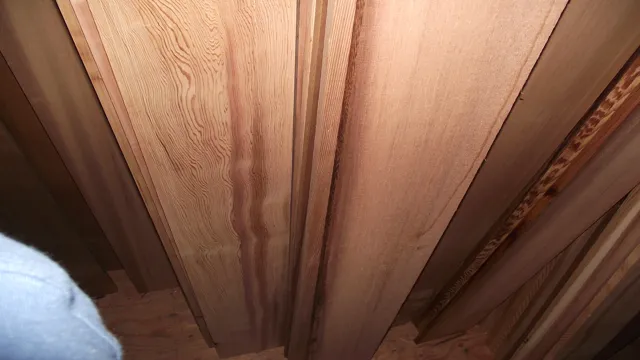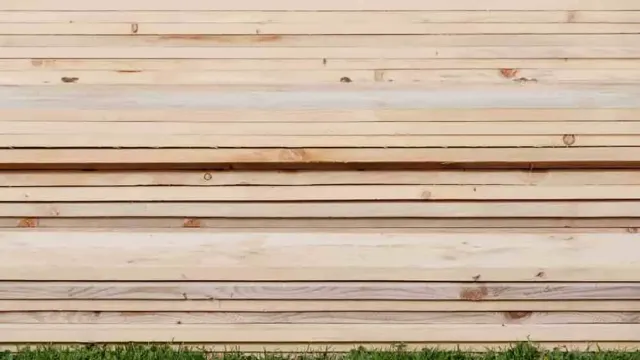
If you’re in the market for plywood, you’ve likely come across the term “shop grade plywood.” But what exactly is it? While some may assume that all plywood is created equal, shop grade plywood has distinct characteristics that make it a unique option for certain projects. In this blog post, we’ll explore what shop grade plywood is, its uses, and how it differs from other types of plywood.
So, whether you’re a DIY enthusiast or professional woodworker, let’s dive in and learn more about this type of plywood!
Understanding Plywood Grades
Shop grade plywood is characterized by its minimal aesthetic appeal and structural integrity. It is commonly used for non-decorative purposes such as storage shelves, subflooring, or temporary structures. Shop grade plywood is the lowest grade available and often contains imperfections such as knots, warping, and splits.
These imperfections can cause structural weakness and make the plywood less aesthetically pleasing. However, shop grade plywood is still a cost-effective option for those looking for a material that can perform basic functions without breaking the bank. It is important to note that shop grade plywood is not recommended to be used in high-stress applications or for projects that require a high level of precision.
Overall, shop grade plywood is an option for those who prioritize cost over appearance and performance.
Plywood Grades
Plywood is a versatile material used for various projects such as furniture, flooring, and construction. When selecting plywood, it is important to understand the grading system. The grading system includes two main classifications – exterior and interior.
Plywood is graded based on the quality of the wood veneers used to manufacture it. The highest grade is A, which means the plywood has no visible defects and is sanded smoothly. Grade B has some visible knots and discoloration, while grade C has more defects such as missing patches and larger knots.
The lowest grade is D, which indicates a high level of defects and is not suitable for finishing projects. Understanding plywood grades is important to ensure you are using the appropriate plywood for your project. Choosing plywood that is too low in grade can lead to a negative impact on the durability of the final product, while selecting plywood that is too high in grade can lead to unnecessary expense.

What is Shop Grade Plywood?
Shop grade plywood is a type of plywood that is commonly used in construction projects. Understanding plywood grades is crucial when selecting the right plywood for your project. Plywood is manufactured using different types of wood, and their grades refer to their quality level.
Shop grade plywood is typically made from lower quality wood, which may have knots, voids, and other imperfections that make it unsuitable for applications that require a smoother and more polished finish. However, it is still strong and durable, making it ideal for use in sheds, barns, and other similar structures. If you are looking for a budget-friendly option, shop grade plywood can be a great choice.
When shopping for shop grade plywood, make sure to inspect it for defects and choose a plywood sheet that has consistent thickness and no visible cracks or splits. By choosing the right plywood grade, you can ensure that your project is both structurally sound and aesthetically pleasing.
Characteristics of Shop Grade Plywood
Shop grade plywood is a type of plywood that is known for its affordability and utility. It is commonly used for projects that require structural support but don’t require a high-quality finish. Understanding the characteristics of shop grade plywood is important when selecting the right material for your project.
This type of plywood typically comes in large sheets and is made up of multiple layers of thin wood veneers. The veneers are glued together with the grain of each layer oriented perpendicular to the adjacent layer. This construction method makes shop grade plywood strong and durable.
However, shop grade plywood is not as aesthetically pleasing as high-end plywood grades. It may have knots, voids, and other imperfections that make it unsuitable for certain applications. Despite its drawbacks, shop grade plywood is a reliable choice for many DIY and commercial projects.
Its affordability and durability make it a popular choice for builders and contractors looking to save money without sacrificing quality.
Uses of Shop Grade Plywood
Shop-grade plywood is a type of plywood that is affordable and commonly used for construction and DIY projects. It’s not intended for finishing and is best used for structural work where appearance is not a priority. One of the most common uses of shop-grade plywood is for subflooring.
It can also be used for shelving, paneling, and as a base for flooring or countertops. However, due to its irregularities, it’s not recommended for furniture making or cabinets. Shop-grade plywood is usually made from lower-quality veneers, and it’s important to inspect it carefully before purchasing to ensure that it’s suitable for your project.
Overall, shop-grade plywood is a versatile and cost-effective option for many construction and DIY projects where aesthetics are not the top priority.
Construction Applications
Shop grade plywood is a versatile building material that has countless applications in construction projects. One of the main uses for this type of plywood is in the creation of furniture, including bookshelves, cabinets, and tables. Shop grade plywood is also used in flooring and wall installation, as it is strong, durable, and able to withstand heavy foot traffic.
Other popular applications for shop grade plywood include roofing, sheathing, and paneling. Its smooth surface and even texture make it ideal for painting and staining, which enables builders and designers to achieve any desired finish or color. Shop grade plywood provides an affordable, yet high-quality option for construction projects where appearance is a key factor, and its versatility and strength make it an attractive option for professionals and DIY enthusiasts alike.
Whether you’re working on a small renovation project or a large-scale construction job, shop grade plywood is a material that is definitely worth considering.
Furniture-making and Cabinetry
Shop grade plywood is a type of plywood that is commonly used in furniture-making and cabinetry. While it may not have the smoothest finish or the most attractive appearance, it is an economical and practical choice for constructing drawers, shelves, and other similar components. It is also used for building furniture frames, as it is strong and sturdy.
One of the main benefits of shop grade plywood is its versatility. It can be easily cut, drilled, and shaped to fit any design or dimension. Whether you’re building a bookshelf or a kitchen cabinet, shop grade plywood can handle the job.
Additionally, it is often less expensive than furniture-grade plywood, making it a popular choice for DIYers and those on a budget. Overall, shop grade plywood is a reliable and cost-effective option for woodworking projects that require strength and durability without sacrificing quality.
Packaging and Crating
Shop Grade Plywood is a popular material used in the packaging and crating industry due to its many benefits. This type of plywood is constructed using high-quality wood veneers, making it extremely durable and resistant to warping and cracking. It is also lightweight, which makes it easy to handle and move around during the packaging and crating process.
Shop Grade Plywood is also an affordable option compared to other types of wood, making it a popular choice for businesses on a budget. Additionally, the material is easy to cut and shape, which makes it perfect for customizing packaging and crating designs to fit specific objects. Overall, Shop Grade Plywood is a versatile and reliable material that is widely used in the packaging and crating industry for its durability, affordability, and ease of use.
Pros and Cons of Shop Grade Plywood
Shop grade plywood is a type of plywood that is typically sold at hardware stores or lumber yards. It is considered the lowest grade of plywood and is often used for temporary or short-term projects where appearance is not a major concern. One of the benefits of shop grade plywood is its affordability, making it a great option for those on a tight budget.
However, there are also some drawbacks to using shop grade plywood. It may have rough edges and knots, making it difficult to work with or causing it to splinter. It may also have inconsistencies in its thickness, making it less reliable for use in structural projects.
Additionally, the quality of shop grade plywood can vary widely between manufacturers and even between different batches from the same manufacturer. Overall, shop grade plywood can be a good choice for certain projects, but it is important to consider its limitations and potential drawbacks before making a purchase.
Advantages
Advantages of Shop Grade Plywood Shop grade plywood is a less expensive option compared to other grades of plywood. It is widely used in construction projects that require durability, making it a popular choice among builders. The main advantage of shop grade plywood is that it has fewer defects, knots, and voids, which makes it easier to work with.
It offers consistent thickness and has a smooth surface that makes it perfect for painting and staining. This plywood type is also lightweight yet strong, making it easier to move around and handle during cutting and installation. Its affordability and durability make it a great option for DIY projects as well.
However, shop grade plywood also has some disadvantages. The appearance of the plywood may not be as attractive as higher grades, and it may have more inconsistencies in its color and grain. Therefore, it may not be suitable for projects where the aesthetic appeal is important.
Despite the cons, shop grade plywood is still a great option for those looking for a cost-effective material that offers reliability and durability.
Disadvantages
Shop grade plywood is a cost-effective option for woodworking projects, but there are a few disadvantages to using this type of plywood. One major disadvantage is that shop grade plywood is not as strong as higher grade plywood. This means that it may not be able to support as much weight or withstand heavy use over time.
Additionally, shop grade plywood may have more knots, voids, and other imperfections than higher grade plywood, which can make it more difficult to work with and may result in a less polished finished product. However, despite these disadvantages, shop grade plywood can still be a good option for less demanding woodworking projects or as a more affordable alternative for certain applications. It is important to weigh the pros and cons of shop grade plywood carefully before deciding whether or not it is the right choice for your project.
Conclusion
In conclusion, shop grade plywood can be thought of as the black sheep of the plywood family. It may not be pretty or perfect, but it gets the job done and can save you money in the process. Like that quirky cousin you only see at family gatherings, shop grade plywood may not be your first choice, but it’s always there when you need it.
So the next time you’re browsing the aisles at the hardware store, don’t overlook this unsung hero of building materials.”
FAQs
What is shop grade plywood?
Shop grade plywood is a type of plywood that is generally considered lower quality and is often sold at a lower price. It typically has more knots, patches, and other imperfections compared to higher-grade plywood.
Can shop grade plywood be used for structural applications?
It’s not recommended to use shop grade plywood for structural applications because it may not have the necessary strength and durability. It’s better to use higher-grade plywood specifically labeled for structural use.
Is shop grade plywood suitable for DIY projects?
Yes, shop grade plywood can be a good option for DIY projects where appearance is not the top priority. It can be used for things like shelving, workbenches, and other non-decorative applications.
How is shop grade plywood different from other grades of plywood?
Shop grade plywood is typically considered a lower grade compared to other types of plywood such as A, B, or C grades. It often has more defects and may not be as strong or durable.
What are the common uses for shop grade plywood?
Shop grade plywood is often used for non-decorative projects where appearance is not important, such as sheathing, subflooring, and storage shelving.
Can shop grade plywood be sanded and painted?
Yes, shop grade plywood can be sanded and painted, but it may require more prep work to ensure a smooth surface.
How can I tell if the plywood I’m buying is shop grade?
Look for labels or markings on the plywood that indicate its grade. Shop grade plywood may also have more visible knots and imperfections. It’s always best to inspect the plywood before purchasing to ensure it meets your needs.








